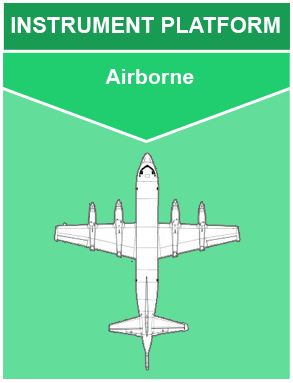Instrument: Water Isotope System for Precipitation and Entrainment Research (WISPER)
The Water Isotope System for Precipitation and Entrainment Research (WISPER) is a counterflow virtual impactor on the NASA P-3 aircraft. WISPER uses a modified commercial Picarro L2120-i δD/δ18O ultra-High-Precision Isotopic Water Analyzer to make in-situ measurements of condensed water contents and water vapor in clouds, along with water vapor isotopic abundances (Henze et al., 2020; Henze and Noone, 2017). The measurement technique is cavity ring-down (CRD) spectroscopy (O'Keefe and Deacon, 1988; Berden et al., 2000; Gupta et al., 2009). WISPER has been deployed to the NASA ORACLES (ObseRvations of Aerosols above CLouds and their intEractionS) and IMPACTS (Investigation of Microphysics and Precipitation for Atlantic Coast-Threatening Snowstorms) field campaigns.

WISPER measures condensed water contents and water vapor in clouds, along with water vapor isotopic abundances which should provide important information about the origin of air masses and possibly, microphysical processes. Water isotopologues have also proven to be very useful for identifying periods of complications in sampling, such as condensation in the sample lines at high condensed water contents and icing.

| PARAMETER | ACCURACY |
|---|---|
| Condensed Water Contents | < 15% for most situations |
| DATASET NAME | GUIDE |
|---|---|
| Water Isotope System for Precipitation and Entrainment Research (WISPER) IMPACTS |
Note: The IMPACTS field campaign is the first time WISPER data have been archived at GHRC.
O'Keefe, A. and Deacon, D. A. G.(1988). Cavity ringdown optical spectrometer for absorption measurements using pulsed laser sources, Rev. Sci. Instrum., 59, 2544, https://doi.org/10.1063/1.1139895.
Berden, G., Peeters, R., and Meijer, G. (2000). Cavity ring-down spectroscopy: Experimental schemes and applications, Int. Rev. Phys. Chem., 19, 565–607, https://doi.org/10.1080/014423500750040627.
Gupta, P., Noone, D., Galewsky, J., Sweeny, C., and Vaughn, B. H. (2009). Demonstration of high precision continuous measurements of water vapor isotopologues in laboratory and remote field deployments using WS-CRDS technology, Rapid Commun. Mass Sp., 23, 2534–2542, https://doi.org/10.1002/rcm.4100.
Herman, R. L., Worden, J., Noone, D., Henze, D., Bowman, K., Cady-Pereira, K., Payne, V. H., Kulawik, S. S., and Fu, D. (2020). Comparison of optimal estimation HDO/H2O retrievals from AIRS with ORACLES measurements, Atmos. Meas. Tech., 13, 1825–1834, https://doi.org/10.5194/amt-13-1825-2020.
Henze, D. and Noone, D. (2017). The Dependence of Entrainment and Drizzle in Marine Stratiform Clouds on Biomass Burning Aerosols Derived from Stable Isotope and Thermodynamic Profiles, AGU Fall Meeting, New Orleans, Louisiana, United States, Abstract A11C-0048.
Henze, D., Toohey, D., and Noone, D. (2020). The Water Isotope Spectrometer for Precipitation and Entrainment Research (WISPER), in preparation.









